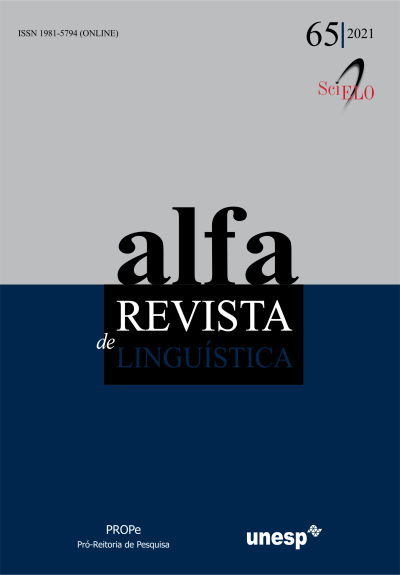As denominações para libélula, no Atlas Linguístico do Brasil
um estudo sobre a motivação dos signos
DOI:
https://doi.org/10.1590/1981-5794-e13455Palavras-chave:
Atlas Linguístico do Brasil, interior brasileiro, variação lexical, libélulaResumo
As denominações atribuídas à libélula, – inseto de corpo comprido e fino, com quatro asas transparentes, que voa e bate a traseira na água – Questão 85 do QSL do Atlas Linguístico do Brasil, representam exemplarmente o complexo sistema variacional do léxico do português brasileiro (PB), refletindo fatos da sócio-história de cada região e, até mesmo, de cada localidade e de cada indivíduo. As variantes registradas no ALiB, publicado em 2014, com os dados das capitais, sugerem que a denominação do inseto é, em geral, de base metafórica, motivada pelo seu aspecto físico, som, movimentos e, igualmente, por associações mentais/analogias com outros semelhantes, resultando, na maioria dos casos, em signos transparentes. A fim de ratificar ou, talvez, retificar os resultados das capitais, analisamos, neste trabalho, os dados coletados no interior do país junto a 900 informantes, perfazendo o total de 225 localidades. Com o apoio desse corpus, norteadas pelos princípios teórico-metodológicos da Lexicografia e da Semântica, objetivamos: (i) verificar a dicionarização das formas obtidas; (ii) descrever as variantes quanto aos aspectos morfológicos; e (iii) analisar essas denominações sob a ótica da semântica motivacional.
Downloads
Downloads
Publicado
Como Citar
Edição
Seção
Licença
Os manuscritos aceitos e publicados são de propriedade da Alfa: Revista de Linguística. É vedada a submissão integral ou parcial do manuscrito a qualquer outro periódico. A responsabilidade do conteúdo dos artigos é exclusiva dos autores. É vedada a tradução para outro idioma sem a autorização escrita do Editor ouvida a Comissão Editorial.

